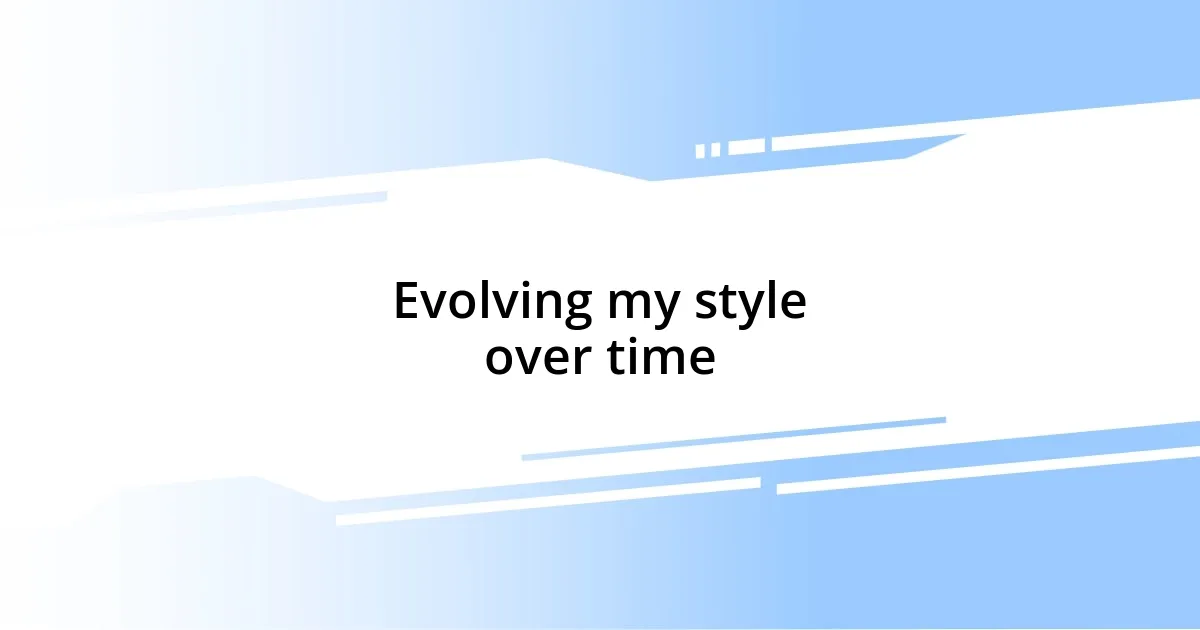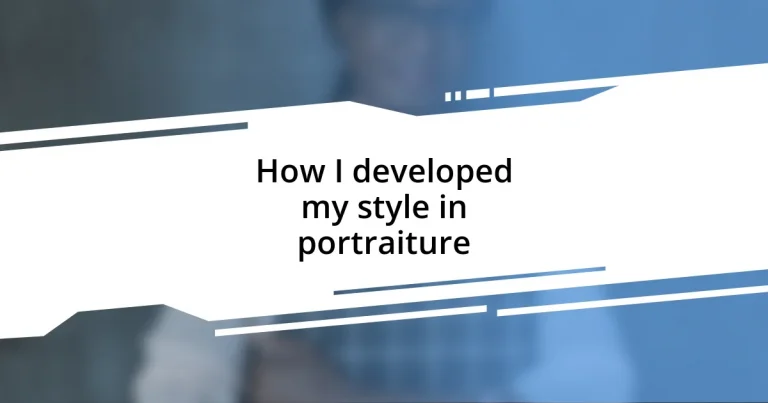Key takeaways:
- Influence from artists like Van Gogh and Frida Kahlo inspired a deeper emotional connection in portraiture.
- Experimentation with techniques such as double exposures and mixed media enriched artistic expression and storytelling.
- Incorporating feedback from peers and mentors led to significant growth and refinement in style.
- Exploring different environments and cultural influences helped discover a unique perspective and narrative depth in portraits.

Discovering my artistic influences
As I delved deeper into portraiture, I found inspiration in the works of artists like Van Gogh and Frida Kahlo. Their ability to convey raw emotion through color and brush strokes resonated deeply with me—how can a single painting capture such a complex array of feelings? I remember standing in front of one of Kahlo’s self-portraits, feeling a connection that sparked my own journey of self-expression.
In my quest to understand different styles, I stumbled upon contemporary photographers like Annie Leibovitz. What struck me was her knack for storytelling through portraits; each image seemed to whisper its own tale. I often wondered, could I evoke such narratives in my own work? That question pushed me to experiment, leading to moments when a single shot felt like capturing a soul rather than just a face.
Reflecting on my artistic influences, I also embraced the candid works of street photographers. There was a thrilling spontaneity there, a reminder that sometimes the best portraits are unplanned. I recall a day when I captured a fleeting expression of joy on a stranger’s face—it was pure magic! In moments like these, I realized that the world is full of inspiration, waiting for artists to explore how it shapes our understanding of people.

Understanding the basics of portraiture
Understanding portraiture starts with grasping the essence of what a portrait aims to achieve. It isn’t just about replicating a person’s likeness; it’s about capturing their spirit, emotions, and character. I remember my first attempts at portraiture where I focused too heavily on physical details, only to realize later that the most compelling aspects of a portrait arise from subtle nuances—like the way someone’s eyes light up when they talk about their passions.
Composition plays a significant role in portraiture, guiding the viewer’s eye to the subject. Experimenting with angles and framing, I discovered that sometimes a slight tilt or unique perspective can dramatically change the feel of the photograph. There was this one time I captured a friend laughing while looking off to the side. The candidness of it sparked something within me—a realization that the environment influences how we see and feel the subject.
Finally, lighting is crucial in portraiture; it can create depth and evoke moods. I learned this lesson during a sunset shoot, where the golden hour illuminated my subject’s face in the most enchanting way. The warmth of that light created an atmosphere that made the portrait feel alive. Moments like these emphasized for me the significance of understanding the basics, laying the groundwork for my evolving style.
| Element | Importance in Portraiture |
|---|---|
| Composition | Guides the viewer’s eye and enhances emotional connection |
| Lighting | Sets mood and highlights features, creating depth |
| Emotion | Captures the essence of the subject, beyond their physical appearance |

Experimenting with different techniques
Experimenting with different techniques has been a pivotal part of my journey in portraiture. I vividly recall one late afternoon when I decided to play with double exposures. There’s something enchanting about layering images that tells a more profound story. One portrait combined a smiling subject with a serene landscape behind them, creating a sense of harmony between person and nature. That particular piece brought about a surge of emotions—like capturing an essence that transcends the individual.
During my exploration, I found it exhilarating to experiment with contrasting styles, such as painting vs. photography. This is how I broke into mixed media, adding acrylic brush strokes to printed portraits. The tactile quality of paint against smooth photo paper made me rethink the boundaries of portraiture. Some of the favorite techniques I tried include:
- High-contrast Black and White: Focusing on emotions by stripping away color.
- Long Exposure: Capturing movement and adding dynamism.
- Natural Textures: Incorporating elements like fabric or flora to enrich narratives.
- Monochrome Schemes: Using a single color palette for mood establishment.
These explorations not only enriched my stylistic approach but also deepened my connection to the subjects in each portrait, revealing layers of their personalities that I hadn’t noticed before. Each technique felt like a new way to converse with my audience, allowing them to feel what I saw through my lens.

Finding my unique perspective
Finding my unique perspective in portraiture has been an enlightening journey. I distinctly remember the day I ventured into urban environments for a photoshoot, seeking the stories hidden behind strangers’ expressions. As I captured a woman lost in thought on a bustling street, I realized the city itself became a part of her narrative. Isn’t it fascinating how our surroundings can shape the emotional depth of a portrait?
Exploring different cultural influences has also shaped my viewpoint. During a trip to India, I was struck by the vibrant colors and the warmth of human connection in every corner. I began incorporating these elements into my portraits, experimenting with vivid backdrops and traditional attire. Each photo felt like a cultural amalgamation—did I capture just an image, or was I telling an entire story with each click of the shutter?
Additionally, collaborating with fellow artists has opened my eyes to new perspectives. Once, I worked with a local musician who shared insights about his music and passion. In our session, I aimed to embody his love for rhythm through movement. It was exhilarating to capture not just his likeness but the essence of his creativity. That moment taught me that every portrait could become a dialogue—not just between me and the subject, but with the audience as well.

Developing a consistent color palette
Developing a consistent color palette was a fascinating journey for me. I remember one summer afternoon spent mixing paints in my studio, trying to find a balance that felt authentic. It wasn’t just about choosing colors that looked good together; I wanted them to resonate with my subjects’ emotions. Have you ever noticed how certain colors evoke memories or feelings? That discovery helped me refine my palette to something truly reflective of my vision.
As I worked, I began to associate colors with moods. For instance, deep blues and soft greens became my choice for calmness and introspection, while bold reds energized my work, infusing it with passion. I once had a portrait session with a dancer who exuded so much energy; I chose a fiery red backdrop that mirrored her spirit. When I captured that shot, the vibrant palette almost danced off the canvas, adding layers of meaning I hadn’t initially envisioned. Isn’t it incredible how color can amplify the essence of a story?
Over time, I brought a select group of colors into my workflow, developing what felt like my “signature” palette. I can recall an enlightening moment when I realized that sticking to these colors offered visual continuity across my works. It made my portraits not just individual pieces but part of a broader narrative. As artists, don’t we all long for that sense of identity in our work? Adopting a cohesive color approach transformed my artistic expression, reinforcing the emotions I aimed to convey in each portrait.

Incorporating feedback into my process
Incorporating feedback into my process has been a game-changer for my portraiture journey. During one particularly pivotal shoot, I was working with a friend who told me she felt her smile looked forced. This honesty caught me off guard at first—who doesn’t want to be flattered? But her feedback nudged me to focus more on creating a relaxed atmosphere, and the resulting portraits captured genuine laughter. Isn’t it amazing how one piece of constructive criticism can spark such a shift?
I regularly seek input from fellow photographers and mentors, finding their perspectives enriching. Once, after sharing my latest series, a mentor pointed out that I often shy away from shadows. Initially resistant, I experimented with their advice, and the dramatic contrast added an unexpected depth to my work. This experience taught me that embracing different viewpoints can push my boundaries. Have you ever felt that thrill when you attempt something outside your comfort zone?
Another low point became a major learning opportunity for me. After a local exhibition, I received mixed feedback about a series I was proud of. While the compliments felt great, the critiques stung. However, rather than dwelling on the discomfort, I took those comments back to my studio. I re-examined the pieces with fresh eyes and discovered areas for improvement that I hadn’t considered before. Isn’t that a testament to the growth we experience by being open to others’ insights? Feedback, while sometimes hard to hear, has ultimately refined my style and made me a more thoughtful artist.

Evolving my style over time
Reflecting on the evolution of my style, I can pinpoint key moments that significantly shaped my approach. I remember a winter workshop where I experimented with lighting techniques. I was captivated by how a single soft light could sculpt a subject’s features, creating a mood so intimate and inviting. Have you ever noticed how light can transform a scene? That realization ignited a passion for exploring this element in my work further, leading me to incorporate various lighting setups in my subsequent portraits.
As my confidence grew, so did my desire to experiment beyond the conventional. I recall a spontaneous session with a musician in a vibrant urban setting. We decided to go with unconventional angles and candid moments instead of stiff poses. The result was a series bursting with life and authenticity, which surprised me. Isn’t it liberating to break free from established norms? This experience taught me that being willing to push boundaries could lead to unexpected and exciting results.
Sometimes, nostalgia pulls me back to my earlier works, where I can see how far I’ve come. I once had a portfolio review where a seasoned artist pointed out my inclination to shy away from bold expression. Initially, I felt apprehensive about embracing that advice, but gradually, I learned to incorporate bolder elements into my portraits. It felt like rediscovering a hidden facet of myself. Does the idea of vulnerability resonate with you as an artist? The journey of evolution isn’t just technical; it’s deeply personal and constantly unfolding.














